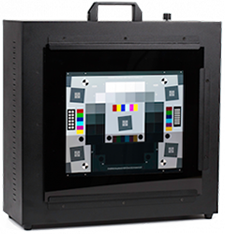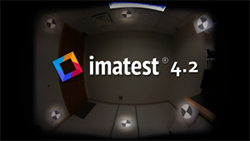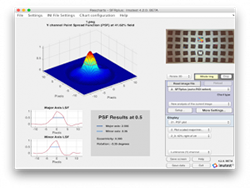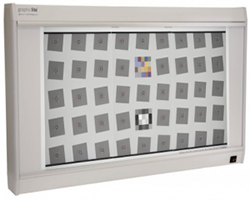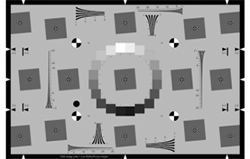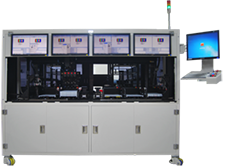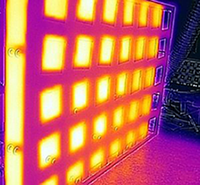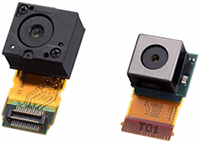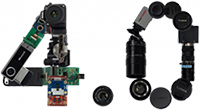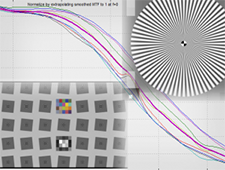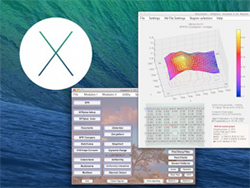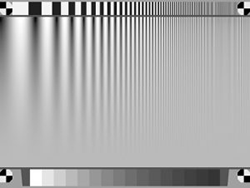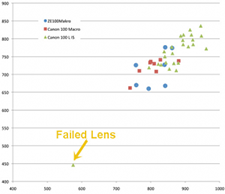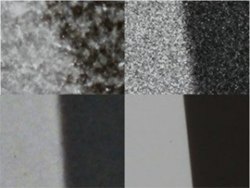High Dynamic Range Target, ITI LED Lightbox
We are pleased to announce our new High Dynamic Range (HDR) test chart with a density range exceeding 120dB (optical […]
Color difference ellipses
Starting with Imatest 4.2, Imatest’s two-dimensional color displays— CIELAB a*b*, CIE 1931 xy chromaticity, etc.— in Multicharts, Multitest, Colorcheck, SFRplus, and eSFR ISO can display ellipses that assist in visualizing perceptual color differences. You can select between MacAdam ellipses (of historical interest), or ellipses for ΔCab (familiar but not accurate), ΔC94, and ΔC00 (recommended).
Imatest version 4.2
Imatest has released Version 4.2. New features include: SFRreg Module: Analyze a camera’s Spatial Frequency Response (sharpness) using automatically-detected slanted edges in […]
4.2 Public Beta Release, Imatest Events
Imatest version 4.2 is now available as a public beta. Join our Beta Test Group to access 4.2 updates. Highlights include:
- SFRreg Module: Analyze the SFR of slanted edges through the automatic
detection of registration mark patterns (circles with two light and two dark quadrants). Use arrays of registration mark targets to test unique imaging systems, including systems with ultra wide angle fisheye lenses (>180 degrees), multiple camera combinations, video and more.

- Point Spread Function (PSF): Imatest can now estimate an imaging system’s loss of resolution (PSF)
using a pair of collocated, near-sagittal and tangential slanted edges on SFRplus, eSFR ISO and SFRreg targets. Easily analyze and improve sharpness, chromatic aberration, and distortion measurements.
New High Precision SFRplus Target for GL-30E Lightbox
The High Precision SFRplus Target for GL-30E Lightbox is our most detailed resolution target. You can test high-resolution devices in compact […]
New Photographic eSFR ISO & June Trainings
New Photographic eSFR ISO The ISO 12233:2014 Enhanced eSFR Photographic Target is our newest reflective test chart. Photographic prints have over twice the resolution of inkjet prints, […]
Announcing Imatest IT Parallel Processing
New Feature: Imatest IT Parallel Increasing testing throughput The new Imatest Industrial Testing Parallel uses parallel processing to improve the throughput […]
Infrared Targets, Correction for Slanted-Edge MTF Measurements
Infrared Targets Standard Imatest inkjet-printed test charts produced prior to February 2016 work in Near InfraRed (NIR) wavelengths out to approximately 1 micron. […]
Selecting a Chart: SFRplus and eSFR ISO
SFRplus and eSFR ISO share many similar features and can be used to perform many similar image quality analyses. However, […]
Measuring Multiburst pattern MTF with Stepchart
Measuring MTF is not a typical application for Stepchart— certainly not its primary function— but it can be useful with […]
LSF correction factor for slanted-edge MTF measurements
A correction factor for the slanted-edge MTF (Edge SFR; E-SFR) calculations in SFR, SFRplus, eSFR ISO, SFRreg, and Checkerboard was […]
A Study of Slanted-Edge MTF Stability and Repeatability
by Jackson K.M. Roland Abstract The slanted-edge method of measuring the spatial frequency response (SFR) as an approximation of the modulation […]
February 2015: Managing Supply Chain Image Quality
Managing Supply Chain Image Quality Imatest just released the white paper Managing Supply Chain Quality with Imatest to outline best practices […]
Imatest 4.0 Release
Imatest is proud to announce the official release of its new 4.0 image quality testing software. The Imatest 4.0 upgrade […]
Slanted-Edge versus Siemens Star: A comparison of sensitivity to signal processing
This post addresses concerns about the sensitivity of slanted-edge patterns to signal processing, especially sharpening, and corrects the misconception that […]
Imatest for Mac OS X 3.10-Beta Now Available
We are happy to announce that Imatest Master 3.10-Beta is now available for Mac OS X Click here to download […]
Sharpness and Texture Analysis using Log F‑Contrast from Imaging-Resource
Imaging-resource.com publishes images of the Imatest Log F-Contrast* chart in its excellent camera reviews. These images contain valuable information about […]
No Perfect Lens, No Perfect Lens Test
Roger Cicala of LensRentals.com has completed the second part of his two part series investigating lens testing.
Imatest 3.10 Released
The release of version 3.10 of Imatest brings a host of improvements to make image quality testing faster and more […]
Transmissive Chart Quality Comparison
Imatest currently sells several transmissive (backlit) test charts, which have a range of substrates, each with specific properties and qualities […]


